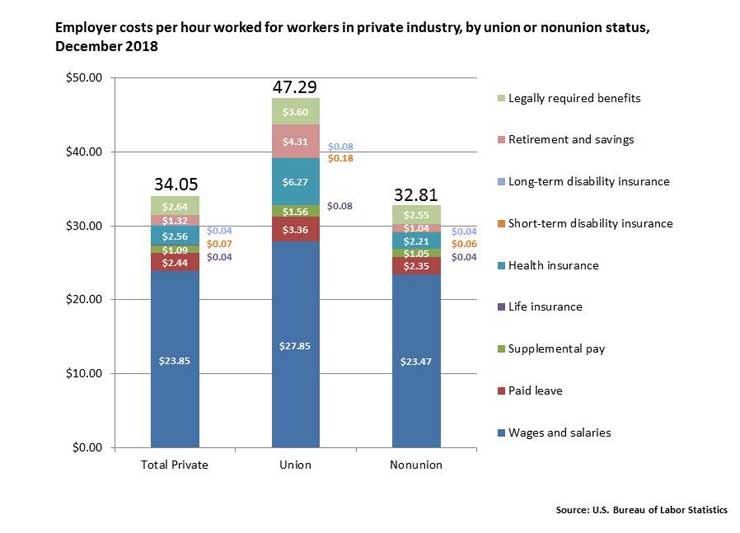What is the Cost of Unions?
 Tangible Cost.
Tangible Cost.
Research indicates that the cost of running a unionized operation is 25% to 35% greater than for a non-unionized one, and this figure does not reflect any negotiated changes in unionized employee wages or benefits. As an illustration consider what we found at a recent Adams, Nash, Haskell & Sheridan national seminar when we reviewed the administrative budgets of a major manufacturing company. This well-known company operates 30 manufacturing plants; half are union free and half are unionized all or in part. The administrative budgets of the unionized plants were 30% higher due to:
- Larger human resources staffs to deal with grievances, job descriptions, rate negotiations, time and motion measurements, and “overcompliance” with government regulations. (“Bird dogs” overseeing workplace statute compliance are less prevalent in union-free facilities.)
- Increased involvement with regulatory agencies, especially those associated with hours and wages, OSHA and the EEOC.
- Expensive indirect costs in the form of outside services, such as the frequent need for a specialized labor attorney to deal with contract negotiations, handle grievances and arbitrations, and review compliance with a collective bargaining agreement.
- Other costs of unions may include:
- Added administrative staff for calculating, deducting and documenting employee union dues.
- Payment for employees who are called in to cover for other employees in steward or representative positions when they are attending to union business.
- Contracting with consultants to develop an action plan for a possible work stoppage or strike.
- Wages for short-term replacements if a strike occurs, which can be significantly higher than striking employees wages, especially if replacements are required for highly trained positions.
- Employees also incur costs when a union wins a NLRB election.
- The average annual cost of union dues is $400, or about two hours of pay per month.
- There is a disinclination of unions toward the contingent worker. Unions want full-time dues payers.
- The employee puts it all on the line during a labor dispute. It is the union employee who is not receiving a paycheck or benefits during a strike.
Intangible Cost.
In addition to obvious increased costs, there are those that affect morale, creativity and resiliency. Ultimately, an organization’s profit margin can decline. Productivity appears to be lower in unionized environments, possibly due to:
- Employee anger or frustration when the collective bargaining process for an initial contract lasts more than a year or does not result in the changes promised by a union during the organizing campaign. (About 75% of initial contracts are still being negotiated a year after the NLRB representation election according to the Federal Mediation and Conciliation Service [1996], and 50% of initial contract negotiations never achieve an executed agreement.)
- Union strategies and rules that impair the employee-employer relationship by playing on employee emotion and interfering with direct employee-supervisor communication, which cast the employer in the role of “enemy” and result in employee mistrust of all management.
- Diminished employee participation in workplace decision making via power sharing programs when such programs had been in place prior to an election.
- Employees having to cope with the divisiveness, name-calling and, sometimes, terrorizing behavior of union coworkers when they disagree in word or deed.
- Less flexibility-both internally and externally-to move quickly or creatively in response to change due to union rules and related contract language that results in rigid operating guidelines.
- Increased difficulty recruiting and retaining the most creative and effective employees. Union-imposed strictures often limit rewarding an employee based on performance or productivity and union grievance procedures tend to protect low-performing and negative employees.
- Decreased client or vendor satisfaction may occur if unionization affects service or product cost or quality.
